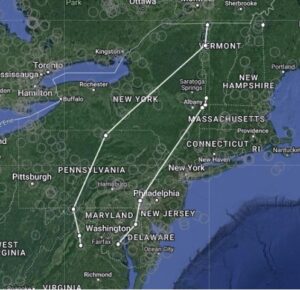Motus network detects “our” Rusty Blackbirds heading north!
(by Carol Foss)
New Hampshire eBird received scattered Rusty Blackbird sightings in March and is receiving almost daily reports in April, but the origins and ultimate destinations of these individuals are unknown. Meanwhile, NH Audubon biologists are anxiously awaiting detections of Nano-Tagged Rusties from the upper Androscoggin watershed breeding population. The first reward came on March 17, when a male that nested a few miles over the border into Maine last year triggered a Motus receiving station on a ridge in Western Maryland. This bird had last been detected on October 27, 2022 in Virginia, a few miles east of Shenandoah National Park.

Then, during the night of April 13-14, a young bird on its first northward migration was detected by three successive Motus stations in Maryland and Pennsylvania. On the night of April 15-16 it was detected by three more stations in eastern New York, western Massachusetts, and southern Vermont. This Rusty Blackbird was captured on July 6, 2022 while traveling along the Maine-New Hampshire border with a group of adults and juveniles. Our crew was able to keep track of it until July 20, after which it disappeared into the Northern Forest for the remainder of the summer. Motus stations in the Champlain Valley of Vermont detected it during October 11-15, after which it headed south and triggered receiving stations in northern Pennsylva
nia on October 24 and northern Virginia on November 2.
We are hoping for detections of more of our tagged birds in the coming days and look forward to tracking them down on the breeding grounds in a few weeks!
